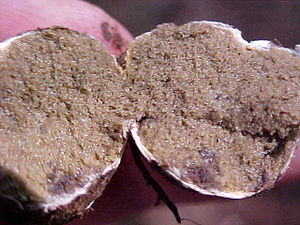Rhizopogon vinicolor
| Rhizopogon vinicolor | ||||||||||||
|---|---|---|---|---|---|---|---|---|---|---|---|---|

Rhizopogon vinicolor |
||||||||||||
| Systematics | ||||||||||||
|
||||||||||||
| Scientific name | ||||||||||||
| Rhizopogon vinicolor | ||||||||||||
| AHSm. (1966) |
Rhizopogon vinicolor is a type of mushroom from the family of the root truffle relatives . It is a collective species for ectomycorrhizae that form mutualistic relationships with Douglas firs ( Pseudotsuga spp.).
description
The fruiting bodies of R. vinicolor are formed underground. They have a diameter of 10… 33 millimeters, are round or irregularly shaped and of a dirty white color; as they ripen, they turn red. A few rhizomorphs sit at the base . The peridium consists of a single layer of hyphae and is - brought to the surface - wine-red. The gleba is firm and leathery yellow in color; it darkens with age. Inside there are small labyrinthine cavities. The trama is well filled with basidiospores . These are elliptical to egg-shaped and measure 5… 9 × 3… 5 μm. They do not have a septum and are smooth and hyaline . The “cords” of the mycelium are only present in small numbers or not at all.
ecology
Although some authors claim that R. vinicolor has only mutualistic relationships with Douglas firs, others are of the opinion that the species also forms mycorrhizae in Ponderosa pines ( Pinus ponderosa ) and other pine or fir species. The trees take advantage of the saprophytic fungus, which makes the nutrients from the leaf litter and rotting wood available, while the advantage of the fungi is that the trees make carbohydrates available for them through photosynthesis .
The West American bank vole ( Myodes californicus ) is one of numerous rodent species that eat the fruiting bodies. The spores then pass through the bank vole's digestive tract and are distributed in their extensive underground burrows with the excrement pellets. Since they are still viable, the fungi are spread in this way and can make associations with trees that have not yet been infected. It was found that if all dead wood, R. vinicolor and other mycorrhizal fungi are cleared and removed, the development of the fruiting bodies will stop, the local bank vole population will die out and the newly planted trees will no longer thrive.
Taxonomy
The species was first described by the American mycologist Alexander H. Smith in 1966 .
A number of Rhizopogon species are so morphologically similar that they have been grouped together as the collective species R. vinicolor . A phylogenetic study of R. vinicolor , R. diabolicus , R. ochraceisporus , R. parvulus and R. versiculosus was published in 2002. The species can therefore be grouped into two separate clades , which are designated R. vinicolor and R. versiculosus .
Individual evidence
- ↑ a b Rhizopogon vinicolor . In: Virtual Mycota . Landcare Research New Zealand. Retrieved August 30, 2019.
- ↑ work = MycoBank Rhizopogon vinicolor . Retrieved August 30, 2019.
- ^ A b Stewart T. Schultz: The Northwest Coast: A Natural History . Timber Press, Inc., Portland, Oregon 1990.
- ^ AH Smith: A preliminary account of the North American species of Rhizopogon . In: Memoirs of the New York Botanical Garden . 14, No. 2, 1966.
- ↑ AM Kretzer, DL Luoma, R. Molina, JW Spatafora: Taxonomy of the Rhizopogon vinicolor species complex based on analysis of ITS sequences and microsatellite loci . In: Mycologia . 95, No. 3, 2003, pp. 480-487. doi : 10.2307 / 3761890 .
Web links
- Rhizopogon sect. Vinicolores Grubisha & Trappe, Mycologia 94 (4): 618 (2002) . In: Index Fungorum . Accessed August 30, 2019: "Record Details"
